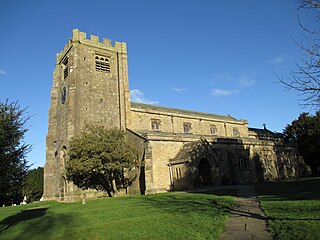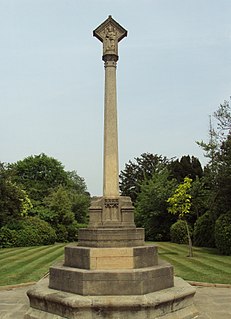
The Hall of Memory is a war memorial in Centenary Square, Birmingham, England, designed by S. N. Cooke and W. N. Twist. Erected 1922–25 by John Barnsley and Son, it commemorates the 12,320 Birmingham citizens who died in World War I.

Broadway is a large village and civil parish in the Cotswolds, England, with a population of 2,540 at the 2011 census. It is in the far southeast of Worcestershire, close to the Gloucestershire border, midway between Evesham and Moreton-in-Marsh. It is sometimes referred to as the "Jewel of the Cotswolds".

St Wilfrid's Church is in the village of Davenham, Cheshire, England. The church is recorded in the National Heritage List for England as a designated Grade II* listed building. It is an active Anglican parish church in the diocese of Chester, the archdeaconry of Chester and the deanery of Middlewich.

The Chattri is a war memorial in the English city of Brighton and Hove. It is sited 500 feet (150 m) above the city on the South Downs above the suburb of Patcham, and is accessible only by bridleway. It stands on the site where a number of Indian soldiers who fought for the British Empire were cremated during the First World War. The structure has Grade II listed status, reflecting its architectural and historic importance. In 2017, as part of the 100th anniversary of World War I, the site of the Chattri was dedicated as a Fields in Trust Centenary Field because of its local heritage and significance.

St Dominic's Priory Church is one of the largest Catholic churches in London. The church is Grade II* listed building on the National Heritage List for England. It has been served by the Order of Preachers (Dominicans) since 1861, the community living in the adjacent Priory. In October 2016, the church was solemnly inaugurated by the Cardinal Archbishop of Westminster, Vincent Nichols, as a diocesan shrine, with a designated mission of promoting the Rosary.

Christ Church is an Anglican church in the Ore area of the town and borough of Hastings, one of six local government districts in the English county of East Sussex. It is one of three Anglican churches with this dedication in the borough. The Decorated Gothic-style church, in the centre of a village which has been surrounded by suburban development, was built in 1858 to supplement Ore's parish church, St Helen's. The most distinctive structural feature, a corner bell turret, has been described as both "outstanding" and "very naughty" by architectural historians. English Heritage has listed the building at Grade II for its architectural and historical importance.

St Paul's Church is in the village of Brookhouse, Caton-with-Littledale, Lancashire, England. It is an active Anglican parish church in the deanery of Tunstall, the archdeaconry of Lancaster, and the diocese of Blackburn. The church is recorded in the National Heritage List for England as a designated Grade II* listed building.

Bredon School, formerly Pull Court, is an independent school in Bushley, Worcestershire, England. The house was built for the Reverend Canon E. C. Dowdeswell by Edward Blore between 1831 and 1839. The site is much older and Blore's house replaced an earlier mansion. The Dowdeswells had been prominent in local and national politics since the 18th century, with many serving as members of Parliament. The family sold the house in 1934 to the parents of Richard Seaman, a prominent pre-war racing drive, who lived there until his death in a crash in the 1939 Belgian Grand Prix. In 1962, the court became a school, Bredon School, founded by Lt-Col Tony Sharp and Hugh Jarrett, for the education of boys who had failed the Common Entrance Examination. It remains a specialist school with a focus on educating children with specific learning difficulties, such as dyslexia and dyspraxia.

All Saints' Church is in Queens Road, Hertford, Hertfordshire, England. It is an active Anglican parish church in the deanery of Hertford and Ware, the archdeaconry of Hertford, and the diocese of St Albans. It is the civic church of the town and of the county. The church is recorded in the National Heritage List for England as a designated Grade II* listed building. It is the largest church in Hertfordshire, other than St Albans Cathedral, and can seat up to 1,000 people.

Clent Castle is a sham ruin castellated folly in the grounds of Clent Grove that is situated opposite the Fountain Inn on Adams Hill in Clent, Worcestershire, England. It was built in the late 18th century by Thomas Liell, and it has been designated by English Heritage as a Grade II listed building.
The Castlebourne folly in the parish of Belbroughton, Worcestershire, England, was built as a sham castle towards the end of the eighteenth century and is similar in age and design to Clent Castle another folly about 2.2 miles (3.5 km) away in an adjacent parish of Clent. In the middle nineteenth century a house, Castlebourne was built in a Gothic castle style close to the folly and connected by a wall about 20 yards (18 m) long and 5 yards (4.6 m) high with an archway. The folly, wall and house are designated as a Grade II listed building by English Heritage.

Croydon Cenotaph is a war memorial, in Croydon, London, England. It is located outside the Croydon Clocktower arts complex, on Katharine Street in Croydon.

The Great Missenden War Memorial is located at the Church of St Peter and St Paul in the village of Great Missenden in Buckinghamshire. The memorial marks the deaths of local individuals who died fighting in World War I and World War II. It was dedicated on 8 May 1920 by the Bishop of Buckingham, Edward Shaw. The memorial is a tall thin stone pillar cross, with a two step base.

The War Memorial is a Grade II listed structure located in the churchyard of the Church of St Laurence in the village of Stanwick.

The Hampstead War Memorial is located in front of Heath House opposite Jack Straw's Castle, on the northern fringes of Hampstead Heath in London. The memorial marks the deaths of local individuals who died fighting in World War I and World War II. It was dedicated on 4 May 1922 by the Bishop of Willesden, William Perrin, in a ceremony attended by Major General Sir Charles Vere Ferrers Townshend. The memorial is a tall thin stone obelisk on a square plinth with a three-step base.

The Dulwich Old College War Memorial is located in the forecourt of Dulwich Old College on College Road in Dulwich in the London Borough of Southwark. It marks the deaths of the former pupils of the college who died in the First World War between 1914 and 1919. The memorial is made from Hopton Wood stone and was designed by William Douglas Caröe. It was unveiled in 1921. It has been grade II listed on the National Heritage List for England since May 2010. The heritage listing places the memorial within a "visual and contextual relationship" with the Grade II listed Old College building and the entrance gates and piers of the Old College, also Grade II listed.

The Dulwich College War Memorial is located at the eastern front of Dulwich College on College Road in Dulwich in the London Borough of Southwark. It commemorates the alumni of the college who died in both the First and Second World Wars. The memorial was designed by W. H. Atkin-Berry, an alumnus of the college. It was unveiled on 17 June 1921, the Dulwich College Founder's Day, by Major General Sir Webb Gillman, and dedicated by the Dean of Durham, James Welldon. Gillman was an alumnus of the college, and Welldon had served as Master of Dulwich College from 1883 to 1885. It has been Grade II listed on the National Heritage List for England since May 2010. The heritage listing places the memorial within a "visual and contextual relationship" with the Grade II* listed Main College building.

The Malvern Wells War Memorial is located on Wells Road in the village of Malvern Wells near Great Malvern in Worcestershire. The memorial marks the deaths of local individuals who died fighting in World War I and World War II. It was dedicated in June 1920 by Lieutenant Colonel W. R. Chichester in the aftermath of the First World War. A a further inscription was later added to mark the Second World War. The memorial is a tall thin Portland stone octagonal pillar topped by a sculpture of a pelican vulning herself, a heraldic and Christian symbol of sacrifice.
Cofton Hall is a country house on the Lickey Hills near Cofton Hackett, in the Bromsgrove District of north east Worcestershire, England. It is a Grade II* listed building.

















